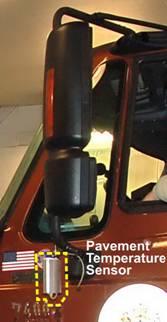4 MaineDOT Maintenance Operations
This chapter provides a description of MaineDOTís winter maintenance operations relevant to this evaluation.
MaineDOT is responsible for maintenance of the state highway system, and in Scarborough in Region 1 they have 18 crew members and 11 trucks. Figure 2 shows the location of Region 1 in southern Maine. MaineDOT has provided an MDSS to all their crews as of the end of winter 2005-2006, though most were initially exposed to the system by October 2006.

Figure 2 . MaineDOT
Maintenance Regions
Two trucks and crew members are typically assigned to the segment of I-295 that is the subject of this evaluation. MaineDOT is interested in applying new technology, such as an MDSS, to enhance efficiency, safety, and consistency in their maintenance operations throughout the state.
The MaineDOT operations center in Augusta coordinates information dissemination throughout the state for winter road maintenance operations. MaineDOT communicates with NHDOT for advanced storm warnings, and the various maintenance crews communicate with each other on a regular basis. The Scarborough crew that operates out of Region 1 used two of their 11 trucks under most circumstances to handle the maintenance requirements on the test segment of I-295.
MaineDOT employs a Maintenance Activity Tracking System (MATS) that has served as a data repository for labor, materials and equipment usage, and unit rates and costs for each of these categories since 2000. Each crew member enters his daily work report into MATS, and these reports are reviewed and approved by maintenance supervisors for payroll. The staff is paid based on the MATS labor hour entries, and these reports must be completed by the following day. Storm event data also are entered into the daily MATS report to document each storm event. A storm that spans across multiple days can be identified in the daily reports. This includes information on precipitation type (selected from categories in a drop-down menu) at the beginning and end of the storm, the date and time of the start and end of the storm, and the actions taken by the maintenance crews, also date and time stamped. Labor time and materials applied to the test segment of I-295 can be extracted from the daily MATS reports, along with the hours charged by the individual crew assigned to this road segment. MaineDOT generated separate MATS reports throughout this evaluation period that focused exclusively on the activities in the test corridor. Resource usage, including vehicles and materials are recorded daily in MATS as well.
The MaineDOT Scarborough crew has traditionally taken a conservative approach to road maintenance before and during winter storm events, in large part because this section of I-295 is a heavily used high priority roadway. For example, they tend to use higher application rates to treat the road surface at the start of a storm in order to increase the likelihood that a heavy treatment will last throughout the storm and reduce the amount of resources needed for plowing and other follow-up activities. If they observe that the snow is sticking to the road surface, then they will add additional salt. They will pre-wet the salt with either magnesium chloride or calcium chloride when the air temperature drops below the range of 22 to 24 degrees Fahrenheit. In warmer situations they will try to use salt brine for pre-wetting as it costs less than the other two chemicals.

Figure 3. Pavement
Temperature Sensor
Historically, MaineDOT has primarily based their winter road treatment decisions on the time of day or night, traffic volumes and how their treatments are reacting to traffic. For example, heavy traffic may rapidly disperse pavement chemical applications. The on-road crews inspect how the tires of vehicles using the road are interacting with accumulated precipitation and the chemical mix on the road surface, in addition to the pavement temperature readings from the plowís onboard infrared pavement temperature sensor, to make judgments about subsequent treatment materials, amounts and timing. MaineDOT has a night patrol and a storm patrol that are typically on the road before a storm event evaluating conditions in real time, digesting information coming in to their radio system from a variety of sources (including their crews and other crews to the north and south of their position), and will notify the operations center when crews need to be called out.
The MaineDOT plow trucks currently only record pavement temperature using an onboard infrared pavement temperature sensor (Figure 3) at the beginning and the end of a session on the road, though readings can be made at any location. These pavement temperature readings are used to support their treatment decisions. However, the lack of location reference in the infrared pavement temperature data hinders the ability of the evaluation to assess variation by geography.
The MaineDOT Scarborough district radio room has been moved to and consolidated with the 24-hour operations center at MaineDOTís headquarters in Augusta. Weather trends affecting Maine are often confirmed with NHDOT through their turnpike toll booth personnel and are passed on to the MaineDOT crew supervisors. NHDOT has often provided MaineDOT with advance notice of storms before they arrive in the Portland area. This process is still utilized in addition to now using the MDSS and the alerts it provides directly to the Scarborough maintenance crew via phone and email.
